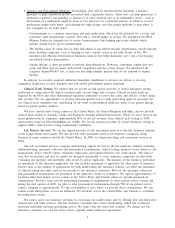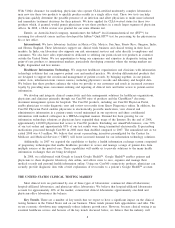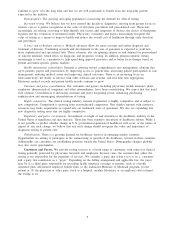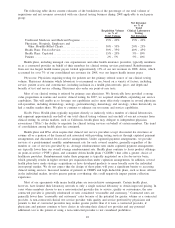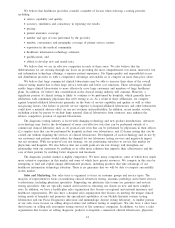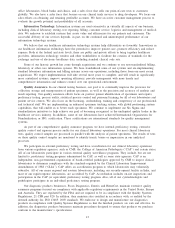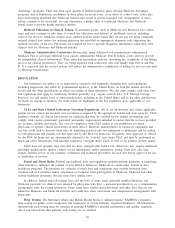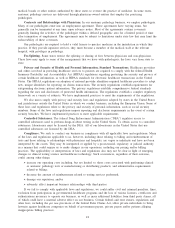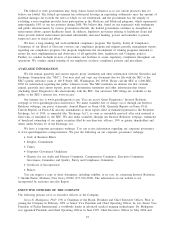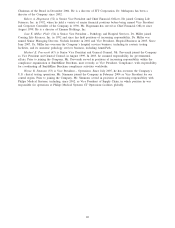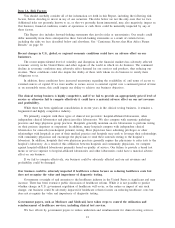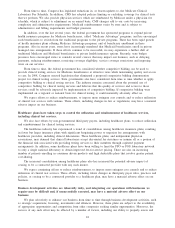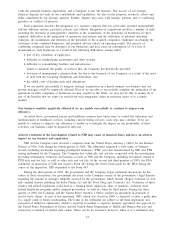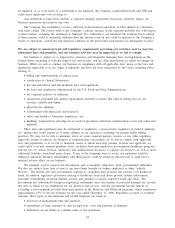Quest Diagnostics 2008 Annual Report Download - page 26
Download and view the complete annual report
Please find page 26 of the 2008 Quest Diagnostics annual report below. You can navigate through the pages in the report by either clicking on the pages listed below, or by using the keyword search tool below to find specific information within the annual report.Intellectual Property Rights. We own significant intellectual property, including patents, patent applications,
technology, trade secrets, know-how, copyrights and trademarks in the United States and other countries. From
time to time, we also license U.S. and non-U.S. patents, patent applications, technology, trade secrets, know-how,
copyrights or trademarks owned by others. In the aggregate, these intellectual property assets and licenses are of
material importance to our business. We believe, however, that no single patent, technology, trademark,
intellectual property asset or license is material to our business as a whole.
Our approach is to manage our intellectual property assets to safeguard them and to maximize their value to
our enterprise. We generally actively defend our intellectual property assets and pursue protection of our
products, processes and other intellectual property where possible.
Our success in remaining a leading innovator in the diagnostic testing industry by continuing to introduce
new tests, technology and services will depend, in part, on our ability to license new and improved technologies
on favorable terms. Other companies or individuals, including our competitors, may obtain patents or other
property rights on tests or processes that we may be performing, particularly in such emerging areas as gene-
based testing and other specialty testing, that could prevent, limit or interfere with our ability to develop, perform
or sell our tests or operate our business.
Employees. At December 31, 2008, we employed approximately 42,800 people. This total excludes
employees of the joint ventures where we do not have a majority interest. We have no collective bargaining
agreements with any unions covering any employees in the United States, and we believe that our overall
relations with our employees are good.
BILLING AND REIMBURSEMENT
Billing. We generally bill for clinical testing services on a fee-for-service basis under one of two fee
schedules. These fees are generally subject to negotiation with or discounted to non-governmental payers. The fee
schedules are:
•“Client” fees charged to physicians, hospitals, and institutions for which a clinical laboratory performs
testing services on a wholesale basis and which are billed on a monthly basis.
•“Patient” fees charged to individual patients and third-party payers, like Medicare and Medicaid.
Billing for clinical testing services is very complicated, and we have compliance policies and procedures that
increase our billing costs. Patients, insurance companies, Medicare, Medicaid, physicians, hospitals and employer
groups all have different billing requirements. Billing arrangements require us to bill various payers, and there are
several other factors that complicate billing (e.g., disparity in coverage and information requirements among
various payers; incomplete or inaccurate billing information provided by ordering physicians). We incur additional
costs as a result of our participation in Medicare and Medicaid programs because clinical laboratory testing and
anatomic pathology services are subject to complex, stringent and frequently ambiguous federal and state laws
and regulations, including those relating to billing and reimbursement. Changes in laws and regulations could
further complicate our billing and increase our billing expense. CMS establishes procedures and continuously
evaluates and implements changes to the reimbursement process.
In 2008, our bad debt expense was 4.5% of our net revenues. We believe that most of our bad debt expense
is primarily the result of missing or incorrect billing information on requisitions and Advance Beneficiary Notices
(ABNs) received from healthcare providers and the failure of patients to pay the portion of the receivable that is
their responsibility, rather than credit related issues. Deteriorating economic conditions may adversely impact our
bad debt expense. In general, we perform the requested tests and report test results regardless of whether the
billing information is correct or complete. We subsequently attempt to contact the healthcare provider or patient
to obtain any missing information and to rectify incorrect billing information. Missing or incorrect information on
requisitions complicates and slows down the billing process, creates backlogs of unbilled requisitions and
generally increases the aging of accounts receivable and bad debt expense. The increased use of electronic
ordering reduces the incidence of missing or incorrect information.
Billing Compliance. As an integral part of our billing compliance program, we investigate reported failures
or suspected failures to comply with federal and state healthcare reimbursement requirements. Any Medicare or
Medicaid overpayments resulting from non-compliance are reimbursed by us. As a result of these efforts, we
have periodically identified and reported overpayments, reimbursed the overpayments and taken appropriate
corrective action.
Penalties for violations of laws relating to billing federal healthcare programs and for violations of federal
and state fraud and abuse laws include: (1) exclusion from participation in Medicare/Medicaid programs; (2) asset
14




